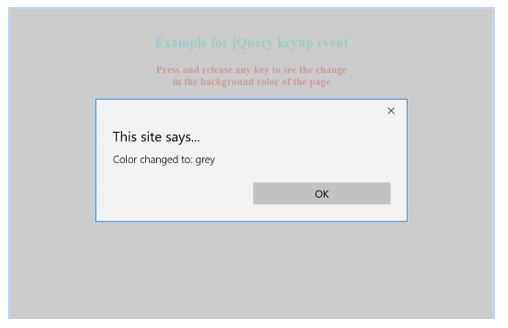

The keyup() method is a shorthand for on( “keyup”, handler ) where keyup is the event parameter. Whenever any key is pressed, jQuery keyup event fires which in turn triggers the keyup() method which then executes the attached handler. This article demonstrated the implementation of jQuery keyup() method with a few examples. In the above example, we saw that each time the key is released, keyup event is sent to the document object which then triggers keyup() method which results in a change of the background color Conclusion

The keyup event occurs once a key is released, which in turn makes the keyup() method to execute the attached function.However, the keypress event is not fired for all keys (e.g. The event occurs when a button is pressed down. The keypress event is similar to the keydown event. The reason behind this color change is that the jQuery keyup() method attaches a function to the selected input box as soon as the keyup event is triggered on releasing the key. keyup - The key is released The keypress () method triggers the keypress event, or attaches a function to run when a keypress event occurs.Now, as we press any key and release it, the background color of the input box changes to coral as shown in the screenshot below.At this point, the background color of the text field is white with no input provided.The below screen gets displayed when the page is first loaded in the browser.Width: 400px height: 300px padding: 20px font-size: medium margin: auto īorder: 3px solid cornflowerblue background: lightgray Įxample for jQuery keyup event Enter any value: Įnter anything in the text box, and the background color will change on key up. $("input:text").css("background-color", "yellow") $("input:text").css("background-color", "coral") This example is the illustration of the working of the keyup() method.

Given below are the examples mentioned : Example #1 keyup: Event is triggered, that is, each time a key is released.function : It is an optional parameter that specifies a function to be executed each time.selector: It is the selected HTML element.To attach a handler/function to the keyup event.

To trigger the keyup event for the selected element. keyup(): This method detects if the key is released.keypress(): This method detects if the key is pressed down.keydown(): This method can find out if a key is on its way down.The event handler can be bound to the input field: $('#target'). Focusable elements can vary between browsers, but form elements can always get focus so are reasonable candidates for this event type. It can be attached to any element, but the event is only sent to the element that has the focus. The keyup event is sent to an element when the user releases a key on the keyboard. bind('keyup', handler) in the first variation, and.


 0 kommentar(er)
0 kommentar(er)
